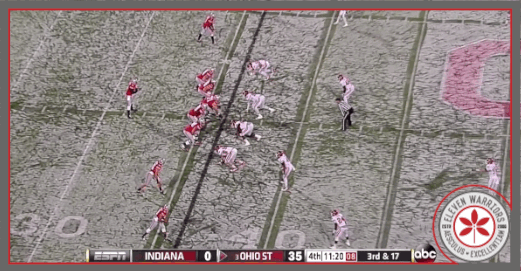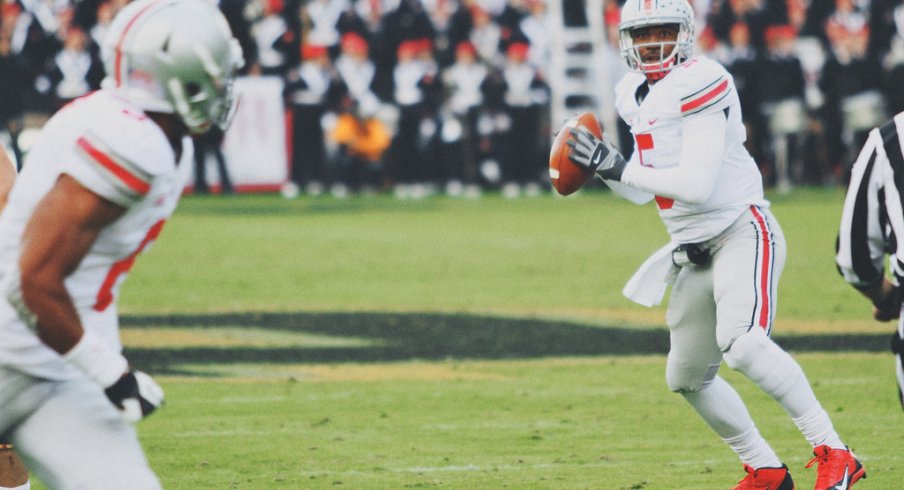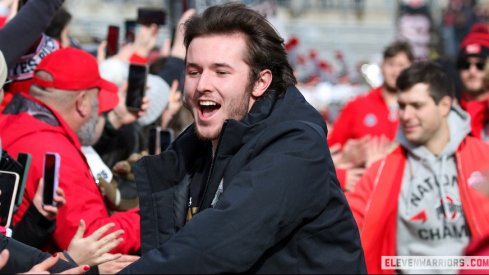While the excitement of last week's NFL Draft has yet to wear off, many scouts, bloggers, and fans alike have already begun looking ahead to the 2015 edition. Nearly every major online sporting publisher has already unveiled a 'Way Too Early 2015 Mock Draft' featuring a number of Buckeyes, such as Michael Bennett, Noah Spence, and even Doran Grant. Notably absent however, is the name of two-time Big Ten Offensive Player of the Year award winner, Braxton Miller.
Miller enters his 4th year as the starting quarterback for one of the biggest programs in the country, leading the Scarlet and Gray to a 24-2 record over the past two seasons. He has tallied 52 passing touchdowns compared to only 17 interceptions, and (often in spectacular fashion) added another 32 trips to end zone on the ground.
The numbers certainly make him as high profile player as any heading into his senior season, yet there is no guarantee that he will hear his name called early next spring when the NFL convenes to select the best players from the collegiate ranks. Being selected in the first round does not correlate to a higher success rate than being taken in a later round, often times the early round pick is given more chances to prove that he can play at the professional level.
Let's look at some of the areas where NFL scouts will be focusing on when they put in the tape of #5.
Arm
Anyone who watched much coverage of last weeks draft likely heard the phrase "able to make all the throws" whenever a quarterback was discussed, and for good reason. Arm strength is an absolute pre-requisite to play in this era of the NFL.
Arm strength doesn't just mean throwing a deep bomb downfield, or a 90 mph fastball though. Defenders are that much more athletic on sundays, meaning they cover even more ground. NFL quarterbacks have extremely small windows in which they must place the ball, meaning the ability to drive the ball across the field on deep routes towards the sidelines is extremely important. With condensed hash marks at the next level, many successful college QBs with average arm strength are exposed almost immediately, as they struggle to effectively use the entire width of the field to challenge a defense.
Luckily for Miller, this is not an area where he'll have to worry. While we've seen him complete countless deep balls and strikes, this incomplete pass against Wisconsin last year might be the best throw he's made during his time in Columbus:
Setting up in the middle of the field and the pocket closing in on him, Miller hits Philly Brown right in the hands on a 25 yard out. Yes, the play is broken up by the hit from the defender, but that's the kind of window NFL QBs are regularly given. With the recent success of condor-like defensive backs such as Earl Thomas and Richard Sherman, the ability to complete passes downfield and to either sideline is extremely valuable to NFL coaches.
Additionally, after watching every throw Miller attempted last season, I honestly can only remember a handful of passes that floated or didn't have a tight spiral. While just getting the ball to your receiver is important, the ability to consistently throw a catchable ball shouldn't be underestimated. Wobbly passes might be slower, but are often more difficult to hang on to than a rocket with a tight spiral.
Mechanics
As mentioned above, arm strength is important, but it's certainly not everything when it comes to projecting success at the next level. Quarterbacks must consistently be accurate with their throws, which more than anything means they're consistent in their ability to deliver the ball.
The best way to develop consistency is to develop great mechanics and muscle memory. Specifically, that means keeping their lower body in tune with what their upper body is doing, both before and during a throw.

On 3rd and 17, Miller does a great job of transferring his weight and stepping into the throw, even though that means stepping right into a blitzing defender. Without that last step, Miller can't drive the ball into the small window, and #37 for Indiana would've likely had the time to recover and break up the pass.
However, as the 2013 season went on, Miller's mechanics began to suffer. Whether it was an issue of confidence, injury, or both, he often relied too heavily on his arm strength to complete passes.
On his first downfield throw of the game, Miller hesitates to step up, leaving his weight on his back foot. Without a normal transferring of weight, the throw becomes entirely dependent on his upper body to complete a pass, which leads to an even more awkward side arm attempt.
The best way to think about a quarterback's footwork and balance is to tie an imaginary string between his eyes and his feet. At all times, that string should be perfectly straight up and down, meaning his feet are moving with him every time he adjusts where he's looking. It's very easy for a QB like Miller to trust too much in just his strong arm. Just because he can get the ball there, doesn't mean it will be in the right spot for his receiver.
It's also true that Miller doesn't always have a high, beautiful release point on his throws, like many others that have been tutored by special QB coaches. The ball never comes up much higher than his earhole, even on deep throws, and some analysts will likely ding him for that. But in reality, NFL coaches won't do anything to fix it. It's clear that when he sets his feet and properly follows through, he can complete any throw asked of him. Those making decisions about his future will be much more worried about the movement of his entire body from head to toe, than that of just his right arm.
Decision Making
With only 17 interceptions in 666 career pass attempts, Braxton Miller has done a very good job of taking care of the football, an absolute necessity for pro quarterbacks. However, Miller at times gets too careful and leaves plays on the field.

On the surface, Miller does a great job mechanically of moving his feet with his eyes, staying balanced, and delivering a great throw. However, he looks at Chris Fields twice before delivering the ball. What can't be seen from this view is the distance between Fields and his defender (#21) the entire time Miller is scanning the field. Miller appears to 'look off' the defender, then coming back to an open receiver, but the receiver was open the entire time.
In the NFL, Miller won't get that second chance with an open receiver. He'll have to trust his abilities and get the ball out immediately. This hesitation started to show up more and more often as the season wore on, but in this instance, one can easily surmise that Miller didn't have the confidence needed to make some of these throws.
It certainly didn't help that he was playing against better competition at the end of the year, but Michigan State and Clemson are better proxies for NFL defenses than Buffalo (other than Khalil Mack), Purdue, or Indiana. Ohio State's early season clash with Virginia Tech will be a great barometer for the Miller's progress in this area, as Bud Foster's Hokie defense is one of the most advanced units you'll find in the nation in terms of both scheme and talent.
Scheme
With the exception of a handfuls of kneel downs, Braxton Miller has operated exclusively out of the shotgun or pistol since the arrival of Urban Meyer and Tom Herman in Columbus after his freshman year. While the NFL has certainly adopted many of the spread offense concepts popular at the college level, NFL quarterbacks must be able to operate from under center. Scouts and analysts will want to know if Miller is capable of executing proper three, five, and seven step drops after taking the snap, but combines and pro days should be able to address this question pretty easily.
Robert Griffin III was in a similar spot two years ago while coming out of Baylor's spread offense, but questions about his footwork disappeared pretty quickly after working out for NFL scouts up close. There is no reason to believe that a personal QB coach, like George Whitfield, won't have Miller ready for such a situation.
Many young player that operate a spread offense can be labeled as "system" quarterbacks though, as Ross noted about Johnny Manziel earlier this week. Many shotgun spread QBs are tasked with making one quick read and delivering the ball based on what one defender is doing, or only running a handful of route combinations.
The Buckeyes have incorporated a number of these reads into the game plan, such as pairing a wide receiver screen with an inside handoff, giving Miller one read of the defensive end to determine where the ball goes. But while this concept is creeping into the NFL, it's often executed only on early downs, and not on 3rd and long, where pro quarterbacks earn their money.
It's not as if Meyer does not also include an advanced passing game though. OSU's focus on the running game creates a passing game built primarily on play-action threat of a running back like Carlos Hyde. The throws Ohio State quarterbacks are asked to make are certainly of NFL-caliber, though.

As noted by respected draft analyst Greg Cosell, making throws such as this one on the back shoulder of the wide receiver are changing the game at the pro level:
Separation is not the defining characteristic needed for them to be dangerous receiving threats. What throw has become such a critical part of the NFL game?: the back shoulder fade. The back shoulder throw is almost impossible to defend against big, physical wideouts like Evans and Benjamin; corners cannot defend two routes, and they must play the deep ball first, so a well-executed back shoulder throw to a big-bodied wide receiver is a tactical nightmare for even the best of corners.
In many cases, Miller simply hasn't had that many opportunities to show NFL scouts that he is capable of taking a snap, dropping back to read a defense, and finding the open man as other quarterbacks. But, the Buckeye offense has executed many of the same concepts found in every NFL playbook, such as Snag, Follow, and Four Verticals, so it's imperative that Miller make the most of those chances when asked to execute in the fall.
Conclusion
Given that we're not in OSU's QB meetings or in the huddle, it's tough to comment much on the intangible that Braxton Miller truly brings to the table. Interviews with he and his coaches will tell the story in that regard, but we know that they've already begun to work on this area. As Meyer told CBSSports.com earlier this spring,
“We're having him watch DVDs. I think Jon Gruden does a heckuva job with quarterbacks. I tried last year (to get him to come). So we're just doing it ourselves. I would try him again. He's a busy guy. (Co-OC Tom) Herman will be Gruden. I'll be doing it big time in June. We'll have him present to us.
Ultimately though, those are tactics are mainly in place to help his draft position. To truly succeed at the next level, he'll need to develop consistency. Miller has shown flashes of brilliance, and an ability to do everything that would be asked of him at the next level (and more).
Against Wisconsin, Miller's confidence in his physical abilities and comfort with the game plan shined through, resulting in a literal highlight tape. NFL scouts and coaches will want to see that kind of game from him every week, not just because he threw four touchdown passes, but because he didn't have any lapses in mechanics or judgment.
Yet the following week against Northwestern, Miller appeared to be a completely different player, with a lack in confidence that translated directly to his mechanics. It wasn't until Kenny Guiton began warming up for Miller to truly find his stride and help lead the Buckeyes to a come-from-behind victory on the road.
Simply put, Braxton Miller has all the tools you look for in a professional quarterback. It's up to him to show NFL scouts those tools on every snap. Here's hoping he'll be able to finally give OSU fans an answer to smug rivals alum to root for on Sundays.


